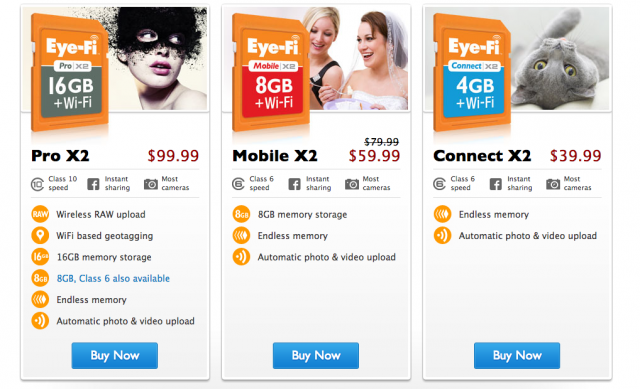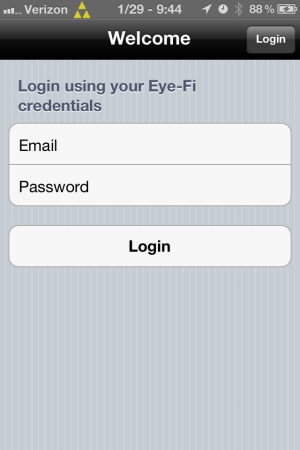
I love technology. I hardly know what to do with myself these days if there isn't some sort of touchscreen device or glowing screen attached to a keyboard at my fingertips.
But I don't love everything about technology—or the decisions made by tech companies. One thing I hate is the trend of gadgets that force you to sign up for a new Internet service just to unlock features that are offline-only. If a piece of hardware is physically capable of performing its most important task without logging on to the Internet, there's no reason it should always be phoning home to some company's servers or forcing me to sign into a cloud service.
Case in point: I recently bought a new camera and decided it was time to get some wireless syncing capability. Taking an SD card out of a camera and jamming it into the appropriate slot on a computer? That's so 2009! I'm no peasant.
I needed a wireless SD card. The first name that popped into my head was "Eye-Fi," so the company's marketing is obviously working. To me, Eye-Fi was synonymous with wireless SD cards like Google is synonymous with search.
Since Eye-Fi memory cards have Wi-Fi built in, you can shoot pictures on a camera and send the images to a phone, tablet, or computer right away, over the air. (Yes, some cameras have wireless built in these days, but mine doesn't.) I read some customer reviews, and most everyone had good things to say about Eye-Fi. I started thinking about what size card to buy, but before pulling the trigger I wanted to see how the system works in practice.
So I downloaded the Eye-Fi iOS app. I didn't have a card to use it with, of course, but I figured I could navigate the interface and see whether transferring pictures would be easy and intuitive. I opened the app and was greeted with this screen:

That's right. To use Eye-Fi, you need to register an account with your e-mail address and a password. But what if you just want to send pictures from your camera to your phone once in a while, without connecting to the Internet? Eye-Fi is more than capable of creating an ad hoc wireless network consisting of just your camera and another device. Internet connectivity shouldn't be a prerequisite to using Eye-Fi, because its most essential feature can be performed without an Internet connection.
You know how often I intend to connect my wireless SD card to the Internet? Never. I probably won't even use it all that often. I may occasionally take a picture with my new awesome camera and want to e-mail or text it to someone. In those instances, I want to be able to transfer the picture to my phone no matter where I am. For that, I don't need to connect to Eye-Fi's servers in some big data center somewhere, and I don't need the company collecting and storing any of my personal information. There are already 7 billion photo sharing services—I don't need another one.
I demand answers!
To make sure I wasn't misunderstanding how Eye-Fi works, I did some searching to see if it can be used without first logging on to the company's servers. I wasn't the only one asking.
"One detail I don't quite get: I'll only use the card (Pro X2) to transfer files from my camera to my laptop, and not to sharing sites/services. Do I need to connect to Eye-Fi for that? An account with Eye-Fi?" one person considering an Eye-Fi purchase asked on the company's forums. "It seems all I should need is the Eye-Fi card, and perhaps to download a firmware update if applicable—as is the case with all other hardware I have—is that not the case with this?"
Although Eye-Fi has a "Direct Mode" that transfers photos directly from the card to your mobile device without an Internet connection, this can't be used until you have an online account with Eye-Fi, the company's user instructions note. On a privacy policy page, the company assures customers that "Eye-Fi is committed to protecting the confidentiality of your personal information."
Photos aren't uploaded to Eye-Fi servers unless customers choose to use extra features like Eye-Fi's cloud storage, automatic sharing to Facebook and other sites, or an Eye-Fi geotagging service.
"When you access your Eye-Fi account and utilize Eye-Fi services, Eye-Fi automatically records certain information about your use, such as account activity, data displayed or clicked on, and other information including browser type, IP address, date and time of access, cookie ID, and referrer URL," the company says. "Some of this information collected, such as IP address and the contents of certain cookies, may include personal information."
Why not give people who spend anywhere from $40 to $100 on Eye-Fi cards the ability to use the hardware's inherent capabilities without logging on to Eye-Fi servers? I contacted Eye-Fi's public relations team directly to find out. Here's the e-mail exchange we had:
Me: Why is an online account is needed, and what is it used for?
Eye-Fi: An online account enhances users’ experiences as it allows them to customize the card based on their needs. The online account provides access to all of a user's images in one place. From here, users can also set up Direct Mode, designate Wi-Fi hotspots or social media sites to post photos and gain access to all the features in the Eye-Fi Center, like Eye-Fi's cloud service, Eye-Fi View.
Me: Is there any way to use Eye-Fi without creating an online account?
Eye-Fi: Since the online features are closely integrated with the cards, there is no way to use Eye-Fi without creating an online account.
Me: What if you aren't connected to the Internet when you want to transfer pictures from your camera to your phone?
Eye-Fi: Sounds like Direct Mode is your answer: You can turn on Direct Mode when you're setting up the card in Eye-Fi Center [an online service]. And once you have the Eye-Fi app on your mobile device, your Eye-Fi card will first look for Wi-Fi, and if it's not within range of an existing network it'll create its own Wi-Fi network. That way you can transfer pictures anywhere.
All's well that ends well
Having ruled out Eye-Fi on principle, I decided to find an alternative. There aren't many, as Eye-Fi was first in this market, but the most viable one I found is the recently released Transcend. Like Eye-Fi, it's a Wi-Fi-enabled SD card that can transfer photos to apps on iOS and Android or to your computer.
For $50, I got a 16GB card with Class 10 speed—half the price of the equivalent Eye-Fi card—perfectly usable without any sort of online account. The card broadcasts a Wi-Fi network, which any device can connect to (it's password-protected, and you can change the password). On mobile devices, you use an app to grab the pictures, and on your computer you use a Web browser. The user experience is straightforward enough:

It lacks some of the bells and whistles that Eye-Fi has, such as Eye-Fi's "Endless Memory" feature that automatically frees up space on your memory card when it's close to full. The user experience for Transcend is sometimes rough as well. Transcend offers an "Internet Mode" that lets you connect the card to the Internet using a Wi-Fi hotspot or your phone's personal hotspot feature. I tested it just to see if it would work, but it didn't, and I quickly gave up trying because the direct-share feature does everything I want the card to do anyway.
All of this is not to say that online accounts or automatic connections to cloud servers are inherently bad. After all, many great services simply wouldn't function without them (say, Dropbox, or apps that sync your reading lists across devices).
But we've seen a trend of companies adding always-on Internet functionality and account requirements to products that would work just fine without them. There were the cases of Cisco replacing its routers' management interface with a cloud service and Razer requiring a mouse to connect to the Internet to unlock all its functionality.
I've got dozens of online accounts, so I'm not avoiding these services when they make sense. Eye-Fi's cloud service probably has great features for those who want it, and there's no reason Eye-Fi shouldn't offer it. But it should be an option, not a requirement.
UPDATE JULY 6, 2013: A little over five months after this article was published, I received an e-mail from Eye-Fi's new CEO, Matt Dimaria. Eye-Fi recently released a new memory card called Mobi, he said. Unlike Eye-Fi's previous products, Mobi can be used with just a camera and mobile device connected directly to each other via Wi-Fi, with no cloud account or Internet connection required. Progress!
reader comments
78